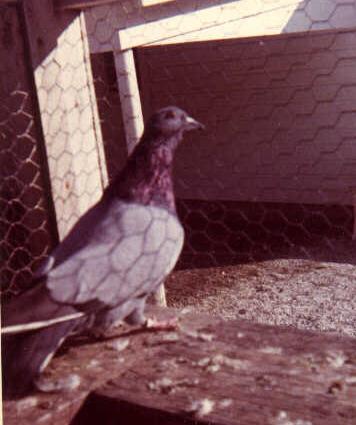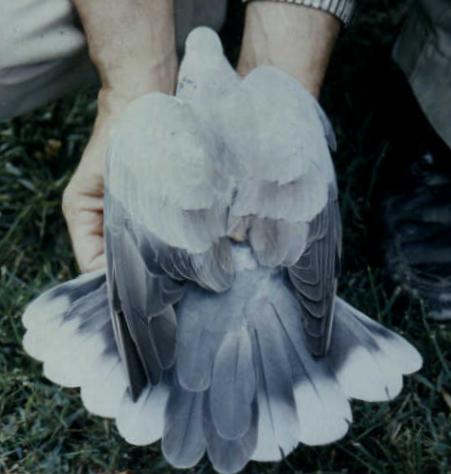Mosaic
- brown vs. wildtype.
(b/., Ts//Ts, V//V?, so//so?, pied)
Photos
Mosaic
- brown vs. wildtype.
(b/., Ts//Ts, V//V?, so//so?, pied)
This pied Toy Stencil blue bar (U-6273 / 1057-C)
is unique - having both wildtype (blue-black) and brown (b) coloration
in its plumage. It is extremely black but not spread (S). Its
rectrices (tail feathers) are white, brown and wildtype. It is the
offspring of a heterozygous brown (+//b) cock and a brown (b/.) hen.
It became very sick and had to be culled before any offspring were produced.
It was believed to be a female; but there is a possibility of mis-identification
of the birds sex. However, if it were a male it is equally unique.
It was under six months of age when culled.
(Photo by Kerry Hendricks)
(pc//pc, S//S?)
(1288-X) AU-89-TEXAS-3784
One of twenty six (26), penciled x gazzi, F2's, all of which displayed much white in their plumage. None were without white (unpied or self colored), or even approaching a near unpied plumage. This data supports what has been suspected for years, i.e., that gazzi (z), recessive white (zwh), and penciled (pc) are alleles. More date is needed.
(Nt//+)
The expression of nasal-tuft in pigeons vary from a neat tuft behind the wattle, at the base of the upper mandible, to several feather whorls on the head. This ash-red checker has additional small whorls over each eye. Sideburns (Sb) produces similar whorls, but in the homozygous state (Sb//Sb) birds display a pronounced abnormal head waving action. Identifying a homozygous nasal-tuft (Nt//Nt) may be difficult. It may prove allelic to sideburns?
This barless "rock pigeon" male was bred from wild rock pigeon stock - said to have been captured in or near Czechoslovakia from "wild" barless rock pigeon populations. Infusion from feral pigeons is suspect, considering the white primary and barless plumage. However, these birds were unusually difficult to hold, being much stronger than domestic birds. Most likely, this line of stock has been lost or diffused over the past 30 years. Note the light-outer tail vane (albescent strip) and the alertness being displayed by the bird.
Barless Rock Pigeon
Photo taken in November 1972.

Pigeon x Dove Hybrid
Photo taken in September 1991.
Given to me as a gift, this male hybrid entered a pigeon fanciers loft in nearby Missouri. Clearly, it appears as a pigeon x ring-necked dove hybrid; but the parent birds were unknown. He was paired to more than one female ring-necked dove and produced many infertile eggs. It died unexpectedly. Photo by Ron Mangile